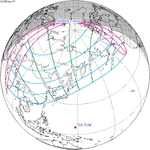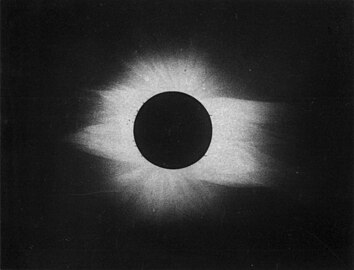| Solar eclipse of January 1, 1889 | |
|---|---|
| Type of eclipse | |
| Nature | Total |
| Gamma | 0.8603 |
| Magnitude | 1.0262 |
| Maximum eclipse | |
| Duration | 137 s (2 min 17 s) |
| Coordinates | 36°42′N 137°36′W / 36.7°N 137.6°W |
| Max. width of band | 175 km (109 mi) |
| Times (UTC) | |
| Greatest eclipse | 21:16:50 |
| References | |
| Saros | 120 (54 of 71) |
| Catalog # (SE5000) | 9255 |
A total solar eclipse occurred on January 1, 1889. A solar eclipse occurs when the Moon passes between Earth and the Sun, thereby totally or partly obscuring the image of the Sun for a viewer on Earth. A total solar eclipse occurs when the Moon's apparent diameter is larger than the Sun's, blocking all direct sunlight, turning day into darkness. Totality occurs in a narrow path across Earth's surface, with the partial solar eclipse visible over a surrounding region thousands of kilometres wide. It was visible across western United States, and central Canada. Partiality was visible across the northern Pacific ocean including Hawaii, and all of the United States.
Observations and predictions[edit]
-
Path across the western United States and central Canada
-
Drawing by Mabel Loomis Todd
-
Photograph taken from Norman, California
Impact[edit]
Wovoka the Paiute prophet received visions during the solar eclipse of January 1889. These visions were framework for the Pan-Indian religious movement known as the Ghost Dance.[1]
Related eclipses[edit]
Saros 120[edit]
This eclipse is a part of Saros cycle 120, repeating every 18 years, 11 days, containing 71 events. The series started with partial solar eclipse on May 27, 933 AD, and reached an annular eclipse on August 11, 1059. It was a hybrid event for 3 dates: May 8, 1510, through May 29, 1546, and total eclipses from June 8, 1564, through March 30, 2033. The series ends at member 71 as a partial eclipse on July 7, 2195. The longest duration of totality was 2 minutes, 50 seconds on March 9, 1997. All eclipses in this series occurs at the Moon’s descending node.
| Series members 55–65 occur between 1901 and 2100 | ||
|---|---|---|
| 55 | 56 | 57 |
 January 14, 1907 |
 January 24, 1925 |
 February 4, 1943 |
| 58 | 59 | 60 |
 February 15, 1961 |
 February 26, 1979 |
 March 9, 1997 |
| 61 | 62 | 63 |
 March 20, 2015 |
 March 30, 2033 |
 April 11, 2051 |
| 64 | 65 | |
 April 21, 2069 |
 May 2, 2087 | |
References[edit]
Further reading[edit]
- Holden, E. S. (1889). "On the solar eclipse of January 1, 1889". The Observatory. 12: 130–134. Bibcode:1889Obs....12..130H.
- Holden, E. S. (April 1889). "On the photographs of the corona at the solar eclipse of 1889, January 1". Monthly Notices of the Royal Astronomical Society. 49 (6): 343. Bibcode:1889MNRAS..49..343H. doi:10.1093/mnras/49.6.343.
- Lockyer, J. Norman (March 1889). "The Total Solar Eclipse of January 1". Nature. 39 (1012): 487–488. Bibcode:1889Natur..39..487L. doi:10.1038/039487b0. S2CID 4097907.
- Payne, William W. (February 1889). "Total Solar Eclipse, Jan 1, 1889". Sidereal Messenger. 8: 64–68. Bibcode:1889SidM....8...64P.
- Pickering, William H. (August 1889). "The Total Solar Eclipse of January, 1889". Sidereal Messenger. 8: 336.1–339. Bibcode:1889SidM....8..336P.
- Pritchett, H. S. (June 1891). "The Solar Corona of January, 1889, from the Photographs". Publications of the Astronomical Society of the Pacific. 3 (16): 155. Bibcode:1891PASP....3..155P. doi:10.1086/120281. S2CID 123421425.
- Taylor, A. (November 1890). "The total solar eclipse of December 21-22, 1889". The Observatory. 13: 348–351. Bibcode:1890Obs....13..348T.
- Todd, Mabel Loomis (1900). Total Eclipses of the Sun. Little, Brown.
- Upton, Winslow; Rotch, Abbott Lawrence; Pickering, Edward Charles (1893). "Meteorological and other observations made at Willows, California, in connection with the total solar eclipse of January 1, 1889". Annals of the Astronomical Observatory of Harvard College. 29 (1). Cambridge: J. Wilson and Son: 1. Bibcode:1893AnHar..29....1U.
External links[edit]
- NASA chart graphics
- Photo of Solar Corona January 1, 1889
- Eclipse of June 1, 1889. Contact print from the original glass negative. Lick Observatory Plate Archive, Mt. Hamilton. [January 1, 1889?!]
- C.E. Watkins photo / eclipse / lick observatory 1889?[permanent dead link], The J. Paul Getty Museum, Object Number: 88.XM.92.83






